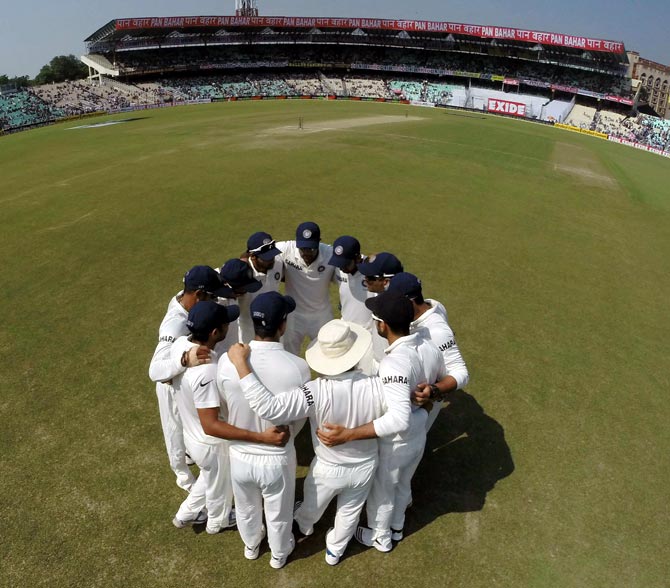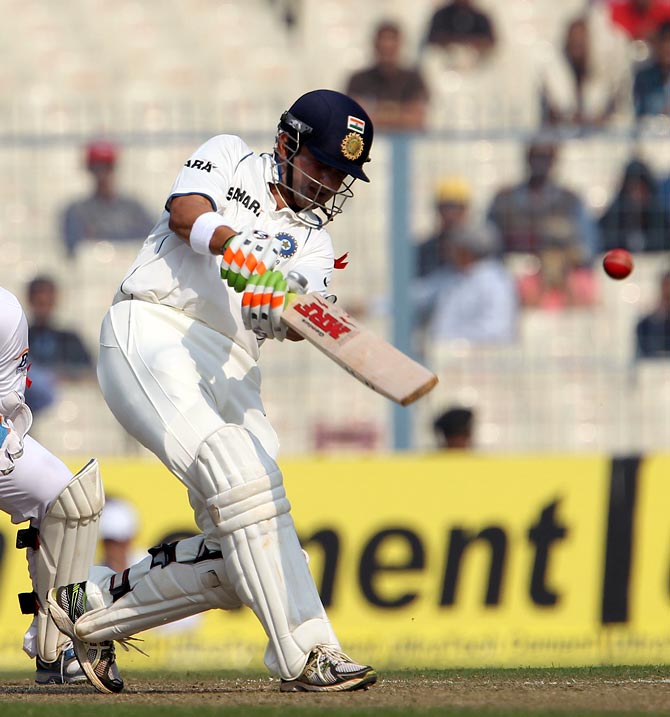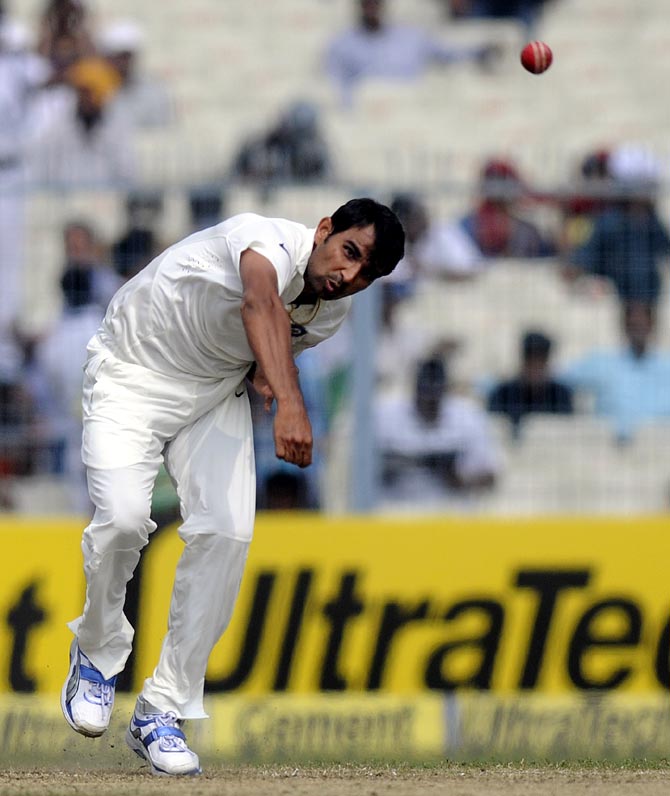Photographs: BCCI Haresh Pandya
The signs appear a bit ominous for a young, talented Indian side on the upcoming tour of England. But, says Haresh Pandya, if the players apply their minds and translate their potential into sterling performances, Mahendra Singh Dhoni should be able to make up for India’s pathetic show in 2011.
Much is at stake, including pride, for Team India as Mahendra Singh Dhoni and company embark on a marathon tour of England featuring five Tests, five ODIs and a Twenty20 game.
Not since 1959 has an Indian team played a five-Test series in England. The rest of the series in England involving India contained either three or four Tests.
Any tour of England, long or short, is not without its own challenges, on and off the field, regardless of whether the home team is powerful or weak. To conquer weather and other conditions, including slower and often unpredictable pitches, calls for more than mere cricket talents. It is rightly said that no cricketer can be called truly great, let alone successful, unless he proves himself and his ability in varied English conditions. For all his willowy wizardry, the redoubtable Doug Walters could never unfold his real genius in England.
The last time India toured England, in 2011, the team had come a cropper in all the four Tests despite being equipped with seasoned campaigners like Sachin Tendulkar, Rahul Dravid, Venkatsai Laxman, Virender Sehwag, Gautam Gambhir and, of course, Dhoni. Chinks in the seemingly star-studded batting line-up were thoroughly exposed and, barring Dravid and to some extent Tendulkar, no Indian batsman could face the formidable English attack with any degree of confidence almost throughout the series. The bowling, too, lost much of its sheen and sting after Zaheer Khan broke down with a leg injury on the opening day of the first Test at Lord’s and was rendered hors de combat for the remaining tour.
While Dhoni’s army is armed with two most potent weapons in Virat Kohli and Cheteshwar Pujara to succeed in England, it is crippled by the recent retirement of his tried and trusted soldiers – Dravid, Laxman and Tendulkar. Worse still, except Dhoni, Gambhir and Ishant Sharma, no other member of the team has played a single Test in England. The signs appear a bit ominous for the relatively younger side, though it possesses some exceptionally talented players who, if they apply their minds and translate their potential into sterling performances, Dhoni should be able to make up for India’s pathetic show in 2011.
- Please click NEXT for more...
Heavy responsibility on Murali Vijay's shoulders
Image: Gautam GambhirPhotographs: BCCI Haresh Pandya
Opener Murali Vijay has figured in 22 Tests but not yet cemented his place in the team and continues to remain unpredictable with the bat. He has the technique and temperament, as well as a perfect game, to shine in England.
With Gambhir returning to the team after a long lay-off, but probably not sure of finding a berth in the playing eleven, and slasher Shikhar Dhawan increasingly unreliable for his tendency to play irresponsible shots even in Test matches, there is a heavy responsibility on Vijay’s shoulders to lay the foundation for a good total by dropping anchor at the other end.
To recall Gambhir for an important tour of England is a wise decision. He is a champion batsman who has already proved his ability in all formats. Petty things like form, or lack of it, should hardly be a hindrance for players like Gambhir provided they are fit and capable of lasting for a few years more. It does not take them long to strike the form or play to their full potential when the occasion is big. Gambhir might not find it easy to get into the playing eleven, but his presence ought to serve as a warning for Vijay and Dhawan, who will have to keep performing.
Chances are that even if the regular openers are in form, but a middle-order batsman or two are not, Team India may risk playing Gambhir, irrespective of where he bats, given his vast experience. It is almost a foregone conclusion that Kohli and Pujara will make the most of the five Tests and, as is their wont, enhance their reputation by essaying some brilliant, mammoth innings. Another batsman whose success in England can be taken for granted is Ajinkya Rahane, who has never ceased to impress since his Test debut against Australia a year ago. If anything, he was one of India’s few successes in South Africa and New Zealand.
For all his great talent and a couple of big innings in his six-Test career so far, Rohit Sharma gives the impression of being an enigma of sorts at the Test level. He will have to show more application and determination to succeed in England. While his approach is very positive, he must understand that patience at the crease has an important place in the serious business of Test cricket.
Despite its inexperience and certain minus points, this very batting line-up, which has Dhoni at No. 7, Ravindra Jadeja at No. 8 and Ravichandran Ashwin at No. 9, who are no pushovers with the bat, can pose serious threats to English bowlers even in England provided they strike collectively pretty consistently. Each and every Indian batsman has proved his worth, even in adversity, at one time or the other, and the team’s success will depend largely on how and how often they perform in unison. In order to compensate for India’s poor bowling, particularly medium-pace, they will have to.
- Please click NEXT for more...
English conditions will best suit Mohammed Shami than any other Indian medium-pacer
Image: Mohammed ShamiPhotographs: BCCI Haresh Pandya
In 2011, even without Zaheer after the first Test, the bowling was in capable hands of new-ball bowlers Shanthakumaran Sreesanth and Praveen Kumar, if not Ishant Sharma, although the home batsmen, as if on a roll, kept plundering runs because the entire Indian team itself had been woefully demoralised right through the series.
Fast bowling is a major concern for this team, whose attack is spearheaded by someone like Ishant Sharma, who will otherwise struggle to get into any national team other than Bangladesh and Zimbabwe. The irony is inescapable that he has played 55 Tests, which shows how bare the country’s pace bowling cupboard is.
It is Mohammed Shami who should be our best bet in Test series as far as fast bowling is concerned. He has the pace, variations and a cool mind, which can both think and listen to others’ advice. Shami has not done badly in his six-Test career and the English conditions will best suit him than any other Indian medium-pacer.
This leaves us with Varun Aaron, Pankaj Singh and Ishwar Pandey. While Aaron has played one Test, Singh and Pandey are yet to figure in any. They might get an opportunity or two in the five Tests, but only excessively optimistic cricket enthusiasts will expect too much from them.
So much has already been said and written about the omission of Umesh Yadav. The fact is he is not picked, whatever the reasons, and it is pointless debating whether he would have been a better choice or not, or whether he would have used the English conditions to his advantage.
Orthodox left-arm spinner Jadeja and off-break bowler Ashwin are in the process of forging India’s lethal spin bowling pair. Some of the English batsmen, yet to recover from the shock defeat in the Ashes battle in Australia, may find the duo too hot to handle when bowling in tandem in helpful conditions, particularly after the first or second day, when the wickets tend to begin to wear a bit.
Just like at home, on this tour, too, India’s chances of bowling out England twice will rest much on Jadeja and Ashwin than on Ishant Sharma, Shami and company. And both Jadeja and Ashwin have it in them to run through this particular English batting line-up, which has no Kevin Pietersen, their best batsman against spinners until recently, to rescue it when in trouble. It will be imperative for India’s seamers to make early inroads into the seemingly strong English batting order for the spinners to torture them further. A daunting task, indeed, but certainly not difficult.
But will the young Indian batsmen persistently stand up to Jimmy Anderson, Stuart Broad and other English fast bowlers on wickets and in conditions tailor-made for them? India’s success, or failure, in the exhaustive five-Test series is likely to revolve round this key question.




Comment
article